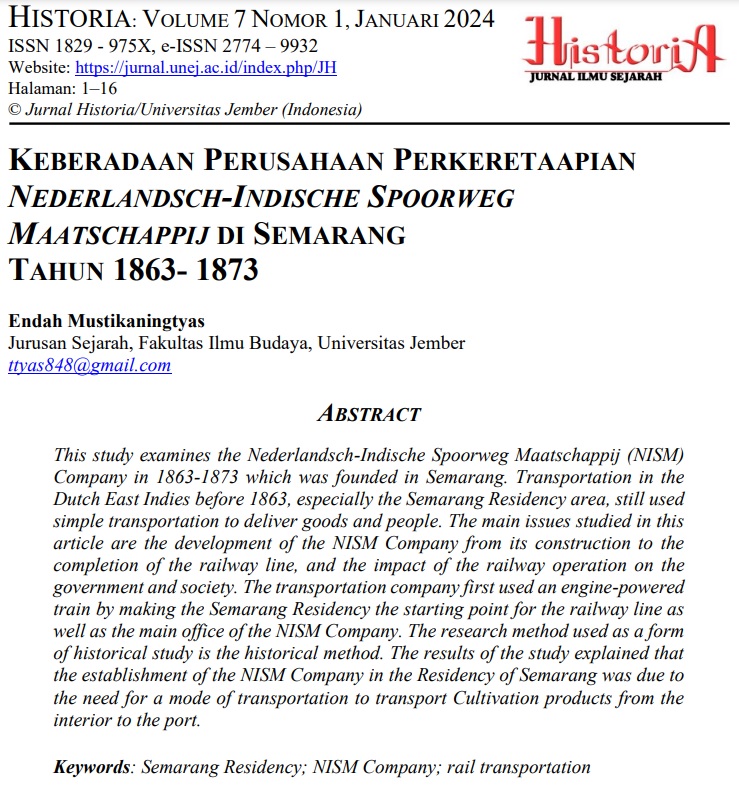KEBERADAAN PERUSAHAAN PERKERETAAPIAN NEDERLANDSCH-INDISCHE SPOORWEG MAATSCHAPPIJ DI SEMARANG TAHUN 1863-1873
Abstract
This study examines the Nederlandsch-Indische Spoorweg Maatschappij (NISM) Company in 1863-1873 which was founded in Semarang. Transportation in the Dutch East Indies before 1863, especially the Semarang Residency area, still used simple transportation to deliver goods and people. The main issues studied in this article are the development of the NISM Company from its construction to the completion of the railway line, and the impact of the railway operation on the government and society. The transportation company first used an engine-powered train by making the Semarang Residency the starting point for the railway line as well as the main office of the NISM Company. The research method used as a form of historical study is the historical method. The results of the study explained that the establishment of the NISM Company in the Residency of Semarang was due to the need for a mode of transportation to transport Cultivation products from the interior to the port.
Keywords: Semarang Residency; NISM Company; rail transportation
References
De Bordes, J.P. De Werken van den Spoorweg Samarang-Vorstenlanden. Gravenhage: Gebr J. & H. van Langenhuysen, 1871.
Gottschalk, L. Mengerti Sejarah [Terj. Nugroho Notosusanto]. Jakarta: UI Press, 2015.
Jellema, R. A. Nederlandsch-Indische Spoorwegpolitiek. 1929.
Kasmir & Jakfar. Studi Kelayakan Bisnis (Jakarta: Kencana Prenada Media Group, 2003).
Marihandono, D; et al. Nalika Tanah Jawa Sinabukan Ril Konsesi NV. NISM di Jawa Tengah 1863-1958. Bandung: PT. Kereta Api Indonesia, 2018.
Nederlandsche Staats-Courant, No. 161, 10 Juli 1874.
Nederlandsche Staats-Courant, No. 173, 24 Juli 1873
Nurhajarini, D.R.; Fibiona, I.; Suwarno. Kota Pelabuhan Semarang dalam Kuasa Kolonial Implikasi Sosial Budaya Kebijakan Maritim, Tahun 1800an-1940an. Yogyakarta: Balai Pelestarian Nilai Budaya, 2019.
Prayogo, Y.B.; et al. Kereta Api di Indonesia: Sejarah Lokomotif Uap. Yogyakarta: Jogja Bangkit Publisher, 2017.
Reitsma, S.A. Dienst der Staatspoor- en Tramwegen: Administratieve dienst No. 1 Indische Spoorweg Politiek [jilid II] (Batavia: Landsdrukkerij, 1919).
Reitsma, S.A. Korte Geschiedenis Der Nederlandsch-Indische Spoor-En Tramwegen. 1928.
Staatsblad van Nederlandsch-Indie, No. 116, 1863.
Stieltjes, T.J. Eenige Beschouwingen over Spoorweg op Java. Rotterdam: H. A. Kramers, 1874.
Stieltjes, T.J. Gegevens Omtrent de Zaak der Spoorwegen op Java. Gravenhage: Gebr. J. & H. van Langenhuysen, 1863.
Suhartono. Bandit-bandit Pedesaan. Yogyakarta: Aditya Media, 1995.
Suryo, D. Sejarah Sosial Pedesaan Karesidenan Semarang 1830-1900. Yogyakarta: Universitas Gadjah Mada, 1989.
Teenstra, M.D. Beknopte Beschrijving van de Nederlandsche Overzeesche Bezittingen (1846).
Tim Telaga Bakti Nusantara. Sejarah Perkeretaapian Indonesia. Bandung: Penerbit Angkasa, 1997.
Tjondronegoro, S.M.P. Dua Abad Penguasaan Tanah: Pola Penguasaan Tanah Pertanian di Jawa dari Masa ke Masa. Jakarta: PT Gramedia, 1984.
Van der Abraham, J. Nederlands Oost- Indie of Beschrijving der Nederlandsche Bezittingen in Oost-Indie. Amsterdam: J. F. Schleijer, 1851.
Wardojo, W.W. Sejarah Kereta Api Kota Solo, 1864-1930. Yogyakarta: Penerbit Kendi, 2018.
Weijerman, A. W. E. Geschiedkundig overzicht van het ontstaan der spoor-en tramwegen in Nederlandsch-Indië. Javasche Boekhandel & Drukkerij, 1904.


This work is licensed under a Creative Commons Attribution-ShareAlike 4.0 International License.










